In this guide, we run through the most important things to know about trading online, including forex trading, stock trading, gold trading and using CFDs.
Learning about trading online can appear daunting, in this guide we breakdown the various aspects into bite-sized chunks. You can read right through or bookmark this page and come back to it.
Contents
1. Choosing a market to trade- Asset classes
- Stocks, fixed income, forex, indices, ETFs, commodities, futures & options, cryptocurrencies
2. Placing a trade- Lots, order types
3. Managing risk- Money mangement, account size, position size, stop losses, take profit orders, risk/reward, leverage, correlation
4. Market Analysis- Technical vs. fundamental analysis, types of price chart, volume, trend analysis, momentum, Japanese candlesticks, tecnical indicators, moving average, RSI, MACD
Choosing a market to trade
Asset Classes
If you are just starting out with online trading you should know about the different classifications of the things you can buy in a financial market. An asset class is a grouping of financial assets. For exmaple among currencies there is the US dollar (USD) and Swiss franc (CHF). Among Stocks there is Amazon and Tesla shares.
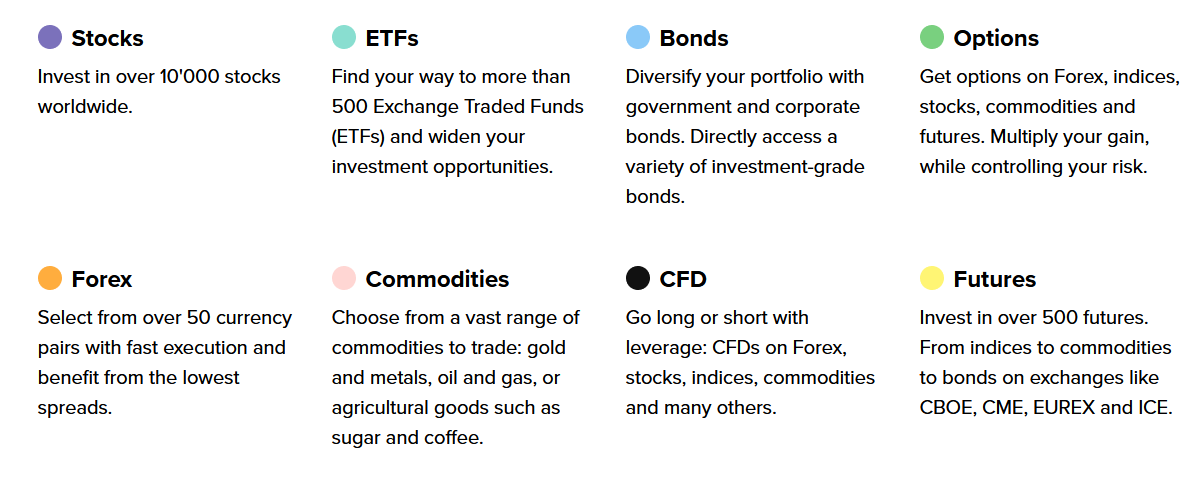
The major classes are explored below in more depth. Most of the time there is little correlation, and even negative correlation between different asset classes which matters in trading and building out a portfolio because of important considerations of diversification.
Stocks
Also called equities, stocks are cash flow producing entities, a business, that generate value over time, and that are listed on a public stock exchange like the London Stock Exchange.
A companies issues shares of stock in the company. Each share is a contract of ownership in a fraction of a company’s business. Public markets are great in that anybody can become part owner of a company. Some famous companies like IKEA are not tradeable on an exchange because they are not public companies. Private companies like IKEA may become public companies after filing for an initial public offering, and companies that are already public like Tesla, may become private once again. Within this asset class, there are sub categories of stocks like blue chips firms and small caps.
Fixed Income
Fixed income means an income that is recurring over time. ‘’Fixed’’ refers to a pre-set periodic payment and ‘’income’’ means revenue. The concept is simple; lend your money to a business or government in return for periodic interest payments.
Money has a price because a dollar today could be used to finance many projects that could grow tomorrow. Tomorrow, your $1 dollar invested could be $2 dollars if that project grows so if you lend your money, you would like to be paid for its use.
Enter ‘’Bonds’’. Imagine a piece of paper from the government (or a digital copy of that paper) that says that if you lend them $1,000 today, they will pay you $25 every month for three years and that at the end of the three years you will get your $1,000 back.
Fixed income. Recurring income over fixed time periods until the bond hits its ‘’maturity date’’. These bonds, or obligations can be short term, or medium term, or very long term. This is also called a debt market, a market where a lot of promises to pay back others are monetized and traded and this market is larger than the equities market.
Forex
Forex is an abbreviation for ‘’Foreign Exchange’’ meaning a marketplace where investors can buy and sell currencies. You can buy American Dollars with your currency and then sell it in return for another currency and so on and so forth with all available currencies.
This is a huge market, and the biggest in terms of trading volume. The point behind trading currencies is that currencies have values that go up and down depending on many economic factors. Such factors include, changes in a country’s money supply, trade dynamics between countries, and demand for a specific currency to earn interest. The Forex market is open all day long five times a week. The goal behind forex is to make profits on price differences between currencies over time.
Indices
If you have heard of the S&P500 you have a sense of what an index is. An index is a broad signal of the performance of a conglomerate of stocks.

The S&P500 is composed of 500 companies and this is a way for market participants to gauge the current stock market climate. There are a variety of indexes that focus on different sectors such as the Russell 2000 Index whose main focus are small cap stock (companies with small market capitalizations).
The famous Dow Jones Industrial Average is used as a proxy to determine the general health of the U.S. economy, and this is what radios allude to when talking about ‘’the markets’’. You need to know this for trading because it will come in handy as a ruler when trading exchange traded funds who often times try to ‘’beat’’ the market index return.
ETFs
An exchange traded fund (ETF) is a publicly traded fund that invests in a basket of companies that you can buy and sell shares of ETFs just like you would a regular stock.
An ETF will buy many different stocks and build a portfolio of companies. Some ETFs focus on a specific industry, some are domestic ETFs others international. There exists a broad variety of ETFs an example being the SPDR S&P 500 ETF (SPY) and ETFs that tracks the S&P500. ETFs contain all sorts of securities like stocks and bonds and commodities.
Commodities
Commodities are things like grains, gold, beef, and oil. These are the everyday basic goods used in households, and by industry.

Commodities are known to move in an uncorrelated way to stocks which is a good way to diversify a portfolio. Commodities are more stable with respect to market volatility but they generate lower returns on investment. Commodities can be traded through ETFs where a fund manager while by the commodity and hold it in a trust or more commonly through a futures contract (next section).
Futures & Options
Options are contracts where an investor pays for the opportunity but not the obligation to buy or sell an asset at a specific price.
There are two type of options, puts and calls. Calls allow you to buy the asset. Puts allow you to sell the asset at the contract agreement date and strike price. If a stock is falling and you have the ability to sell (put) your option at a high price, you win. If the stock is going up and you exercise the right to buy at a lower price, you win. The point is that you pay money to have the opportunity to either sell or buy a stock a predetermined price for a specific duration of time.
Futures are different. They were designed originally for the producers of the commodity as a hedging tool against changes to prices due to things like the weather. Nowadays, most trading is done by specualtors (traders). A futures contract enables someone to buy a commodity at a pre specified price with the option to take delivery at that price at the end of the contract (typically 3-months).
Cryptocurrencies
Cryptocurrencies like Bitcoin and Ethereum are tradable digital assets that are traded on exchanges through a platform such as Coinbase. They are also traded through exchange traded products like ETNs. You can also trade public companies that mine bitcoin.

Placing a trade
Once you know which market you will trade, the next steps is know how to practixcally place the trade. To do this some understanding is needed of the contracts that are traded and or the different types order you will make to your online broker.
Lots
A lot in forex markets is the number of units a trader will buy or sell on an exchange. A round lot is 100,000 units of currency. It is also possible to trade micro lots and mini lots of 10,000 and 1,000 units respectively. Futures and commodity markets also have contract size minimums such as 10oz of gold or 100 barrels of oil.
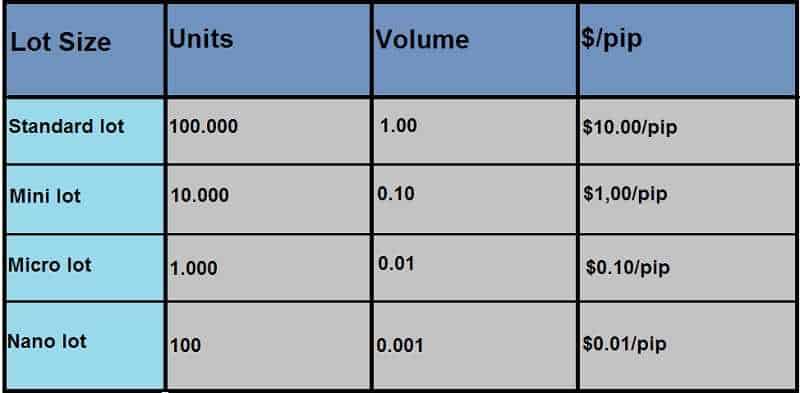
Order Types
- Market Order – An immediate order to execute at the market price.
- Limit Order – A conditional order to buy or sell, but only at a certain price, in an attempt to protect a potential profit or minimize a loss. Buy limit orders mean placing a trade at or below a defined price. Likewise, sell limit orders mean executing a trade at or above a defined price.
- Stop Quote Order – A sell stop quote order is placed at a stop price below the current market price and will trigger if the best bid is at or lower than the specified stop price. A buy stop quote order is placed at a stop price above the current market price and will trigger if the best offer quote is at or higher than the specified stop price. Once triggered, a stop quote order becomes a market order, and execution prices can deviate significantly from the specified stop price
- Stop Quote Limit Order – Investors generally use a stop quote limit order to either limit a loss or protect a gain on a security. A stop quote limit order combines the features of a stop quote order and a limit order. A sell stop quote limit order is placed at a stop price below the current market price and will trigger if the national best bid quote is at or lower than the specified stop price. A buy stop quote limit order is placed at a stop price above the current market price and will trigger if the national best offer quote is at or higher than the specified stop price. Once triggered, a stop quote limit order becomes a limit order (buy or sell, as applicable) at a specified limit price, and execution may not occur as the market price can move away from the specified limit price.
- Trailing Stop Quote Order – A trailing stop quote order is similar to a traditional stop quote order; however, the stop price will adjust with changes to the national best bid or offer for the security. The trail value can be a fixed dollar amount or a percentage. If the calculated stop price is reached, the order will activate and become a market order.
- Trailing Stop Quote Limit Order – A trailing stop quote limit order is similar to a traditional stop quote limit order; however, the stop and limit prices will adjust with changes to the national best bid or offer for the security. The trail values can be fixed dollar amounts or percentages. If the calculated stop price is reached, the order will activate and become a limit order using the calculated limit price.
Managing risk
It surprises many newbie traders to learn that the amount of risk they take on each trade is often more important than the prices at which they choose to buy and sell. “How can this be so?” I hear you ask. The answer comes from understanding a simple truth about trading, and that is that you will have losing trades.
Money Management
Clearly, trading is not physically dangerous, it predominately involves sitting at a computer or on a smartphone trading app. The risk that all traders must avoid is losing too much money that it prevents them from trading. Risk management is the most important thing for a trader to minimise trading losses.

Making a risk management plan will help avoid unexpected results and plays a big role in becoming a more consistent trader. The idea of money management is universal across the stock market, forex trading or futures and options. The rules that fit into your risk management plan can fit into seven neat categories.
Account size
The number one rule for risk management is not to put money at risk in the market that you cannot afford to lose. Curiously, accepting that you could lose all your money is one of the surest ways to avoid it happening.
That is because you will aware of the consequences of not being careful and following your risk management rules. Put simply, the amount in your trading account should be an amount that will not affect your lifestyle if you lose it nor will it keep you awake at night worrying about it.
However, the amount in the account should also be meaningful enough that you still care enough not to want to lose it. Smaller amounts in a trading account also make things like ‘position size’ which we discuss next harder to manage.
Position size
Now you know how big your trading account should be, the next part of the equation is to know how much to risk per trade.
Day trading is very different from an investment portfolio in this way. An example investment portfolio might have 10 stocks, each weighted 10% of the account size. A day trader will tend to risk much less per position because the frequency of new positions is much higher.

Day traders tend to risk 1%-3% of their account per trade. So if the account is valued at $100,000 then $1000-$3000 would be risked per trade. Why so low? Let’s do the maths. Statistically over 10,000 trades when on average the trader wins 50% of their trades- sometime there will be a losing streak of 13 losing trades in a row. 13x 3% = 36%. Here you would lose over a third of your account, something that clearly wants to be avoided.
Stop losses
A stop loss is an automatic order to close your trade a pre-defined amount of loss. This order type is used by experienced traders who understand that successful trading comes from cutting losses quickly and letting winners run. The number of points you risk per trade is determined by your trading system. The stop loss order is just a way to make sure you stick to your system, especially for times when you are away from the trading platform. Even with a mobile trading app, you may be busy and unable to execute the trade.
Take profit orders
A take profit order is used to lock in a pre-defined amount of profit on a winning trade. The purpose for using this type of order is to make sure the plan for the trade is carried out. Newbie traders will often change the plan mid-trade by taking profits too quickly, leaving available profit on the table. It’s important not to try to take too much from the market, just execute your plan and close out the trade.
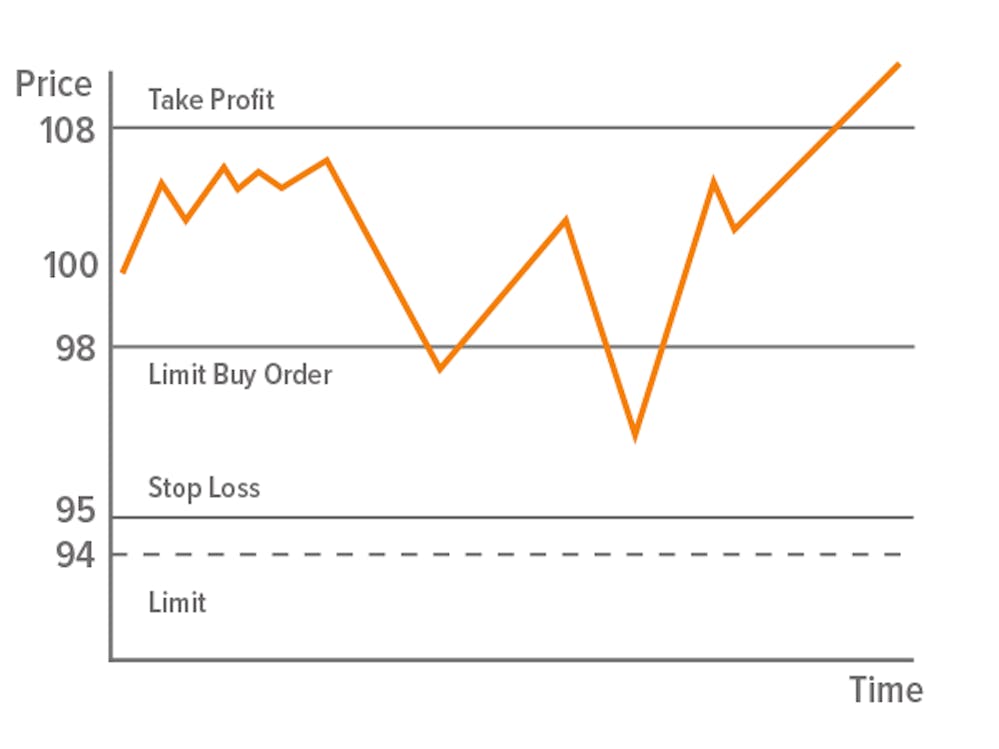
Risk: reward
This is the relationship of the stop loss to the take profit order. More specifically it is the ratio between the expected profit from the trade to the expected loss. There is no right or wrong ratio, the most important thing is to be consistent. Textbooks often cite a minimum risk: reward of 2:1 – meaning that your expected win should be two times the size of your expected loss. However, some trading styles have it completely the other way around and still make money. A scalper will take a series of very small wins but will every so often absorb a big loss so the risk: reward might be 1:10, again the importance comes from defining it and being consistent.
Leverage
Leverage is the size of the trade relative to the size of the trading account. If you place a trade worth $200,000 but you have $100,000 in your account- then this would be using leverage of 2:1. Typically forex trading accounts have relatively high leverage because of the large contact sizes involved.

A forex of CFD trading account for example could have leverage available of 50:1. That would mean $1000 is enough to control a position worth $50,000. The most important element of leverage from a risk management standpoint is the margin requirement and how much spare equity your account has above that margin requirement.
Correlation
Financial markets don’t operate in isolation, they are all inter-related to a greater or lesser degree. The dollar affects gold, gold affects gold miners, gold miners affect the stock index affects… and it keeps going. This is especially true in forex markets where quite often the USD is involved. The important thing is to understand which markets are strongly positively and negatively correlated in order to avoid increasing your risk. For example buying USD/JPY and USD/CAD at the same time would be buying the dollar twice.
Market analysis
A lot of new traders put all their time into the market analysis and forget everything else, that is why we have left it until the end. Still, it is very important to have a method of market analysis for determining where to buy or sell and at what prices to enter and exit the market. Trading on a ‘gut feeling’ is inconsistent and unsustainable over the long run.
Technical analysis vs. fundamental analysis
Fundamental analysis is an attempt to evaluate the underlying value of the asset you are trading and deciding whether the current price under or overvalues it. For analysing stocks and shares, a trader will look at the company’s balance sheet, health of the industry etc. For forex trading, a forex trader might evaluate economic data like GDP for a country to determine likely moves in the currency. However, this is not something we will delve into deeply here.
The other way to analyse a market is through technical analysis. This is the analysis of historical price and volume data to judge future price trends. The main tool used by a technical analyst is the chart.
Price chart types
The FlowOne trading platform shows the 3 main chart types (or chart styles). That is candlesticks, bar chart and line chart. The three types of price charts are plotted with time on the horizonal axis and price on the vertical axis.

Each chart type shows how price moved over a period, you can set the time period for each chart - for example 1 hour, 2 hours, 1 day, 1 week etc. The line chart will show you the closing price for each period. The bar chart and candlestick chart show you the opening price, highest price, lowest price and closing price (known as OHLC) over that same time period.
Volume
Volume can be measured in different ways but the most common is just the total number of contracts that have traded over a period. The volume is typically plotted at the bottom of the chart as a histogram - and each bar or candle will match one period in the volume histogram. Analysts use the relationship between price and volume to determine future movement in the price.
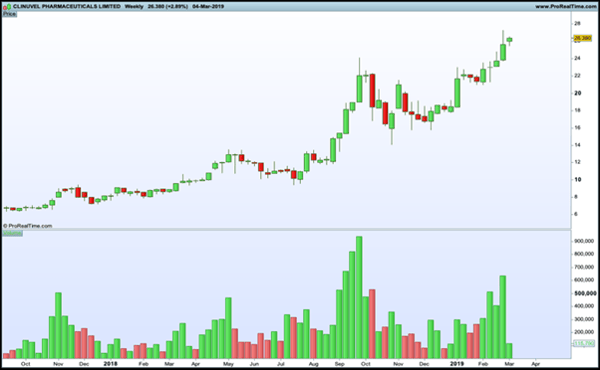
Trend analysis
Before any effort is made to understand price patterns and technical indicators, the very first thing any trader must to is determine the current trend in the market. There are indicators to support this, but the simplest method is to simply observe the slope of the chart. The chart can only be doing one of three things, trending up, down or sideways.
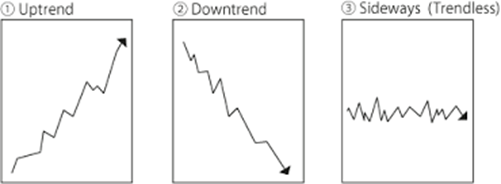
Beyond the slope of the chart, traders can look at what is happening at the turning points, known as ‘highs’ or ‘lows’. In an uptrend, the price will make higher highs and higher lows, while in a downtrend the price will make lower highs and lower lowss.
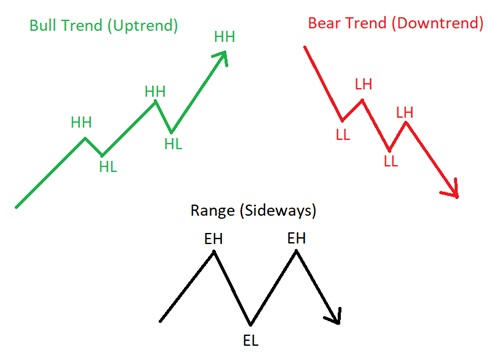
Momentum
It is time to take a trip down memory lane to your high school physics lessons and Sir Isaac Newton. Momentum is the impetus gained by a moving object. In this case the ‘object’ is price. Price momentum is the speed at which the price is changing. Momentum can be measured by eye, looking at the steepness of the slope, or with mathematical indicators.
If we relate this back to our study of trends, we might say that an uptrend is gaining momentum or losing momentum, likewise for a downtrend. This is useful because you ideally want to buy just as the uptrend starts gaining momentum and sell as the price starts to lose momentum.
Japanese candlestick patterns
How the Open, high, low and closing price relate to each other over one or two periods tends to repeat in useful patterns over time. This technique was first used in Ancient Japan by rice traders but is now commonplace in modern day markets. The patterns fall into one of three groups ‘reversal’ patterns, ‘continuation’ patterns or a pause.
Here is a cheat sheet showing some of the most popular Japanese candlestick patterns.
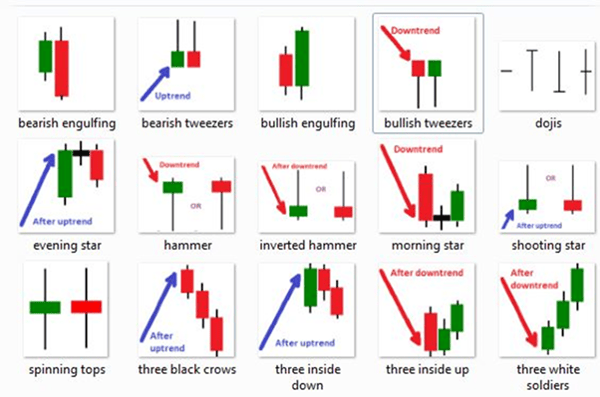
Technical indicators
Now that we have established the main tools to use the price itself for analysis, we can move on to mathematical equations for what the price has done, known as technical indicators. These indicators are split into two main categories ‘overlays’ and ‘underlays’. As the name suggests, overlays go over the top of the price and underlays go in a separate box underneath the price chart. We cover some examples of each in the next sections. One variation of the underlay is an oscillator, where the indicator will normally be a line that oscillates between -1 and +1.
Moving average
A moving average is simply the average price over the last 20 period, going back through time. An example might be the 20-day moving average. The current value of the moving average is the mean of the last 20 days, however when the price opens the next bar or candle, the average will adjust by calculating the new average including the latest day and dropping the price from 21 days ago.
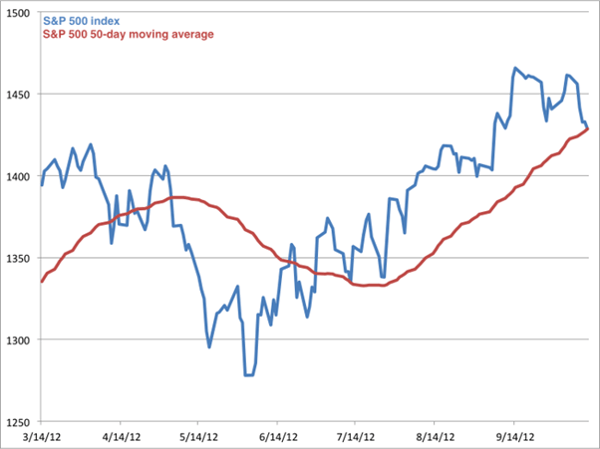
You can see from the above example that the moving average smooths out the price, while lagging the price. It is therefore best used for determining the trend of the market. While the price is above the moving average and the moving average is sloped up, there is an uptrend. While when price is below the moving average and the moving average is sloped down then there is a downtrend.
RSI
The RSI stands for Relative Price Index. It is an example of an oscillator. It is most often used as a way to determine when the market is overbought or oversold - meaning that momentum has gotten overextended in one direction- and can often foretell a snap back in the price in the other direction. The RSI tends to be best used in rangebound or sideways markets because when there is a trend it can remain overbought or oversold for long stretches of time.
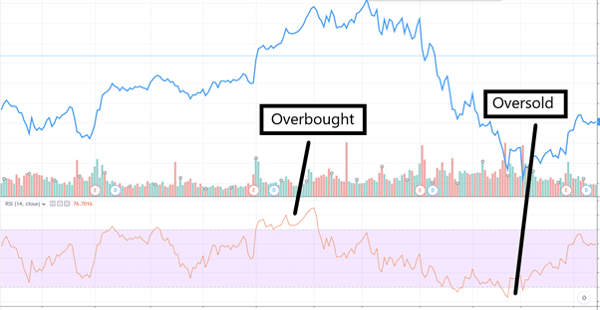
Another popular way to use RSI is to look for divergence. That’s to say when the price makes a new high in an uptrend or a new low in a downtrend but the RSI does not -this can be a leading indicator that the price trend is about to reverse.
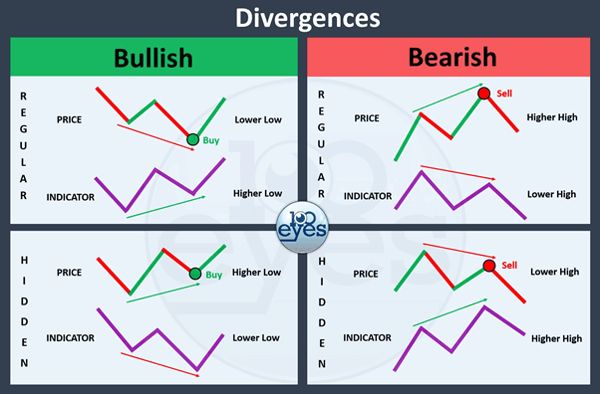
MACD
Another popular underlay indicator that is not an oscillator is the MACD, which stands for Moving Average Convergence Divergence. This can also be used as an overbought or oversold indicator or with divergence, just like the RSI. However it is more commonly used to verify the trend. If the MACD is over the zero line, it signals an uptrend, whereas a MACD below the zero line signals a downtrend.
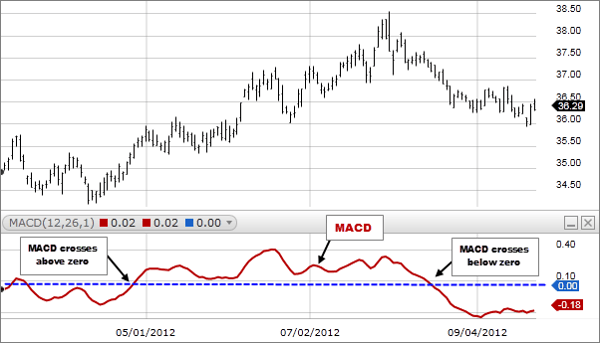
Some traders while use the zero line on the MACD as a trigger to open and close trades, where as other will use it to determine the trend and whether they want to be buying or selling.
Conclusion
After reading this guide, you can now congratulate yourself- you are no longer a complete beginner. While we have covered all the major aspects of trading, we of course were only able to scratch the surface.
Your next steps should be to open a demo trading account to get yourself familiar with the trading platform and where to find the different things we have discussed in this guide. Then in order to the practise, the only way is to test your wits in a live trading account where you can feel the real life fear and greed of having your real money on the line.
We have many more detailed guides for you to read and watch on the FlowBank website to further develop your knowledge in these areas. Good luck !




